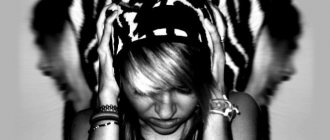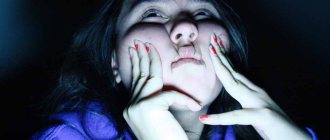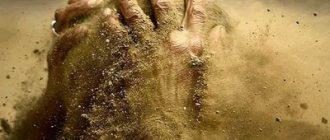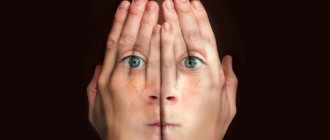A significant place in the practice of a dermatologist is occupied by skin diseases comorbid with mental disorders. According to W. Tress et al., mental disorders are observed in 35.5% of patients in dermatological clinics. According to German dermatologists O. Braun-Falco, G. Plewig, H. Wolff, about 20% of all those suffering from chronic dermatological diseases exhibit certain psychopathological disorders. Among dermatoses primarily caused by mental pathology, a very interesting nosological unit, insufficiently studied and little known to doctors of many specialties, is trichotillomania. Trichotillomania (TTM) is a disorder of habits and impulses characterized by noticeable hair loss due to repeated unsuccessful attempts to suppress the urge to pull it out. Corresponds to code F63.3 in ICD-10. TTM is the subject of study of a new branch of dermatology - psychodermatology, where dermatologists work together with psychiatrists to restore lost health to the patient.
STORY
The term “trichotillomania” was introduced in 1889 by the French dermatologist Francois Henri Hallopeau (1842-1919), who presented the medical community with the medical history of a young man suffering from itching of the scalp. When the itching became unbearable, the patient would tear out his hair in passion. The phenomenon was called trichotillomania. The name comes from three Greek words: trich - hair, tillo - tearing out, pulling out, mania - pathological attraction. Francois Henri Hallopeau In 1968, ED Vaughan, JL Sawyers and HW Scott described Rapunzel syndrome (named after the main character in the Brothers Grimm fairy tale of the same name about a girl with very long hair) - a type of intestinal obstruction caused by the systematic ingestion of hair (trichophagia), resulting in which causes a conglomerate consisting of hair (trichobezoar) to form in the stomach and small intestine. FV Mannino and RA Delgado in 1969 noted that TTM occurs more often in girls than in boys. In their opinion, the main cause of the disease is the disharmonious relationship between mother and child in early childhood, and TTM can only be treated with psychotherapy. In the domestic literature, O.B. was the first to describe TTM. Feltsman in 1918. In the USSR, the most patients were analyzed by V.I. Garbuzov (1971) and V.M. Bykov (1983).
Question for psychologists
Asked by: Olga
Question category: Dependencies
14.02.2017
Hello! My daughter Dasha, 8 years old, has been pulling out her eyelashes for about 2 years now. She took me to a neurologist and an ophthalmologist. They checked and everything is fine. He studies well. Everything is fine at home, the family is complete and prosperous. There is a younger daughter, she is 5 years old. Their relationship is good. Dasha herself says that this happens when she is bored, for example during a reading lesson or when she cannot sleep. And it started with Dasha’s explanation after participating in a beauty contest. I was applying eyelashes to her for a photo shoot and she was disturbing her and she wanted to take it off. Then there was a long feeling of mascara on my eyes and it turned into a habit. I don’t know how to help Dasha get rid of this habit. Please help me help my child!!! Thank you!
My child is very slow, what should I do?
TOP best advice from psychologists The child is very slow, what should I do? (3 answers) The child is too emotional. What to do? (3 answers) My child is addicted to spice, what should I do? (2 answers) All advice from psychologists (406,909 tips in total) Get recommendations from the best psychologists! Psychologist online for FREE or contact a psychologist anonymously See the catalog of psychologists online or contact a psychologist on Skype You can also contact a psychologist
EPIDEMIOLOGY
Previously, it was mistakenly believed that TTM was an extremely unusual and rare disease. However, epidemiological studies have shown that TTM affects from 1-3% to 5% of the planet's population. Among the patients, females aged 11-16 years predominate. There is an opinion that the real number of cases of TTM is underestimated due to the denial of their behavior by some of the respondents, as well as their tendency not to seek help. This may particularly apply to men who claim androgenetic alopecia to hide their condition. In addition, practicing dermatologists are often unaware of the existence of this disorder and may not ask patients whether they pull out hair.
ETIOPATHOGENESIS
Leather and its derivatives, incl. pilosebaceous follicles are well innervated by a dense network of afferent and efferent nerve fibers. This factor is important in the pathogenesis of self-induced dermatoses, since the skin often becomes the focus of tension reduction and emotionally regulated behavior, especially during states of arousal. TTM most often occurs as a syndrome within the framework of obsessive-compulsive disorder (obsessive-compulsive disorder), depression, post-traumatic stress disorder, schizophrenia, organic brain diseases, congenital developmental anomalies (mental retardation, mental retardation), but can also act as an independent systemic neuropsychiatric disorder. Children who are brought up in strict conditions especially often suffer from TTM, when excessive demands are placed on the child, which he is not able to fulfill, which leads to the formation of a neurotic personality. The role of factors of emotional influence, sexual abuse, cruel treatment, and emotional deficit at an early age is great. In such cases, TTM is the child’s protest reaction to the current situation. Feeling self-inflicted pain can reduce internal feelings of isolation and distress. Individuals with TTM experience significant structural changes in the brain. During the study, they were found to have an increase in the density of gray matter in the left striatum, the left amygdala-hippocampal formation, as well as bilaterally in some areas of the cerebral cortex (including the cingulate gyrus, some motor gyri, as well as the frontal gyri). decrease in cerebellar volume. Map of gray matter volume changes (in blue) in patients with TTM compared to Montreal Neurological Institute (MNI) controls overlaid on a standard template. Sections are presented with Z-coordinates. Expected number of false-positive cluster tests Gray matter density of the brain in healthy subjects and patients with TTM for each of the three clusters defined in the permutation analysis. Cluster 1, left hippocampus, left amygdala, left putamen; Cluster 2, bilateral anterior/middle cingulate cortex, bilateral supplementary motor areas, bilateral anterior frontal cortex; Cluster 3, left superior/middle occipital cortex, left superior/inferior parietal cortex The role of serotonin deficiency in the pathogenesis of TTM is debatable (the so-called theory of neurochemical imbalance). Some researchers consider a lack of serotonin as a provoking factor for TTM. As evidence, they cite the good effectiveness of SSRI antidepressants in treating the disease. However, according to F. Penzel, antidepressants can increase the severity of TTM. In a double-blind study conducted by Christenson GA and colleagues, the effectiveness of fluoxetine and other SSRIs could not be confirmed. Scientists have concluded that such drugs have limited use in the treatment of TTM and can often cause significant side effects. In all likelihood, the use of SSRIs can be considered as a treatment for TTM associated with mental disorders. If TTM acts as an independent disorder, such pharmacotherapy is ineffective. Recently, a study was conducted at Duke University (USA) indicating that TTM is hereditary: scientists were able to identify two mutant versions of a gene called SLITKR1 (responsible for the formation of connections between neurons in the brain), which were found with increased frequency in people suffering from this disease. If this defect is indeed the cause of the development of TTM, this will allow the development of more effective methods for treating the disease. The development of TTM may be associated with a defect in the Hoxb8 gene. In experiments on mice, scientists have proven that a reduced level of glial macrophages caused by a defect in Hoxb8 causes a pathological urge in animals to pull out their own fur. After bone marrow transplantation, most mice recovered and grew fur, but some healthy mice that received mutant bone marrow became ill. Studies are currently being conducted in people with TTM to determine whether they carry mutations in the Hoxb8 gene.
Trichotillomania: causes
The sudden development of trichotillomania may be due to the following provoking factors:
- stressful situations - loss of loved ones, divorce, fear, scandals in the family;
- neuroses, depressive states, schizophrenia;
- emotional lability and mental instability;
- injuries of the skull and brain, concussion;
- childhood mental trauma;
- hormonal disorders;
- allergic reactions to medications;
- iron deficiency anemia, lack of copper in the body;
- neurosis of obsessive situations;
- alcoholism and drug addiction;
- bulimia.
CLINICAL PICTURE
TTM can debut at different ages: 1) childhood (2-6 years).
Such TTM (described in the literature as “baby trich”) most often resolves spontaneously by puberty; 2) adolescence is the most common time of onset of TTM. The disease in adolescents is chronic, with relapses, because in most cases associated with mental disorders; 3) bimodal course (the first peak - in preschool age, the second - at the beginning of puberty); 4) adulthood (extremely rare) – frequent relapses are characteristic. Thus, the later the disease begins, the more severe it is. There are 3 types of hair pulling: 1) automatic (unconscious) - more often observed in childhood. Such patients pull out hair without realizing it. The process occurs during an exciting activity or severe stress. Sometimes a person does not even know that he is pulling out his hair: those around him point this out to him and the consequences in the form of bald patches. Some patients describe their state at such moments as a trance; 2) conscious (focused) – for such people TTM is an important ritual. Most often the process takes place in solitude. A person prepares for the procedure: he arms himself with tweezers, creates a suitable environment; 3) combined. In most cases, the patient spends a total of 1 to 3 hours a day pulling out hair. Addictive behavior is usually hidden (patients wear hats, wigs, false eyelashes, long sleeves), and can be combined with onychophagia (nail biting), trichophagia, self-harm of the skin (scratching and removing the resulting crusts). Favorite places for hair pulling are the easily accessible frontoparietal region, eyelashes, eyebrows, pubic hair, body and facial hair. Some patients do not limit themselves to pulling hair out of their own body. They pull out hair from other people (so-called executive TTM), pets, toys and dolls. A patient is described who persuaded his wife to let him pull out her gray hair because, in his opinion, it was unnecessary on her head. Fibers and threads may be pulled out of clothing or furniture. Pulling out hair from the scalp. An age dependence of the localization of foci of baldness in TTM has been revealed: - in adults - the scalp, less often - eyebrows, eyelashes, pubic hair and other areas of the body;
‒ in children – more often eyelashes and eyebrows;
‒ in teenagers – mainly pubic hair.
Eyebrow pulling
Childhood variant of the disorder
The development of trichotillomania in children is primarily influenced by the way they are raised:
- The disorder in most cases develops in a child with a developed sense of guilt or an inferiority complex. This is facilitated by raising children in an atmosphere of increased severity, total control, constant reprimand and inflated demands;
- overprotective parenting model;
- coldness, lack of attention. So, a 4-year-old boy pulled out all the hair on his head. When his mother brought him to the reception, during the conversation it became clear that the boy was experiencing an acute lack of parental love. The father drinks heavily, so he does not pay attention to his son. The mother works two jobs to support the family. Due to lack of time, he communicates little with the child;
- conflicts between parents, their parents' divorce.
The lack of an emotional response from loved ones also affected the 9-year-old girl Lena. She did not have a father, her mother paid little attention to her daughter, devoting all her free time to organizing her personal life. Lena has a guilt complex. The girl believes that she caused her mother a lot of grief. She is constantly told stories about how her mother suffered during pregnancy. The birth itself caused complications in the uterus, which had to be removed.
DIAGNOSTICS
Diagnosis of TTM is based on the collection of anamnesis and examination of the patient. Criteria for diagnosing TTM (Diagnostic and Statistical Manual of Mental Disorders (fifth edition) – DSM-5):
- Periodic pulling out of one's own hair, leading to hair loss.
- Repeated attempts by the patient to stop such actions or reduce their frequency.
- Hair pulling causes clinically significant distress or disruption in social, occupational, or other areas of importance to the patient.
- Hair pulling or loss cannot be explained by another medical condition (eg, dermatological).
- Hair pulling is not a symptom of another mental disorder (such as the patient's attempts to improve perceived defects or deficiencies in appearance, which can be observed in body dysmorphic disorder).
For the psychiatric assessment of TTM, a questionnaire is used. Many psychometric scales have been developed abroad to assess the severity of TTM (Massachusetts General Hospital Hair Pulling Scale, Psychiatric Institute Trichotillomania Scale, National Institute of Mental Health (NIMH) TTM severity scale, etc. .). The main objectives of the survey are to find out: 1) the average time spent on hair pulling; 2) ways to resist the urge to pull out; 3) is it possible to control the urge; 4) how the patient feels before and after pulling out; 5) degree of subjective discomfort; 6) the impact of the disease on the quality of everyday life. During a dermatological examination, the following are determined: - areas of thinning hair or baldness on the scalp, eyebrows, eyelashes, pubis; - foci of alopecia are single or multiple, round, linear or bizarre in shape; - the skin in areas of baldness is normal or rough to the touch; - the mouths of the hair follicles are clearly marked; - hair is usually of different lengths, may be broken off in the middle or look like small black dots or stubble; - skin excoriations in areas of baldness and manifestations of pyoderma are not uncommon - crusts covering excoriations, pustules, erythema, swelling; - no peeling; ‒ hair-pulling test along the edges of bald areas is negative. Trichoscopic signs of TTM: - reduced hair density; - hair broken off at different lengths; - short hair with symptoms of trichoptilosis (split ends); - unevenly twisted hair; - blackheads (cadaverized hair, which are comedon-like follicular blockages); - presence of vellus (short vellus hair); - hair powder (remains of the hair shaft damaged as a result of mechanical action); - absence of hair in the form of “exclamation marks” (dystrophically altered hair, narrowed in the proximal part). Videodermatoscopy for TTM (photo from the collection of Doctor of Medical Sciences, Prof. Yu.V. Sergeeva) An additional sign is the examination of the fingernails - in patients they are very sharp and shiny as a result of constant friction. Infection and damage to the skin of the fingers, which constantly pull out hair, are possible (the tips of the thumb and index fingers are most often affected). A trichogram can be of great help in diagnosis, the analysis of which reveals: - anagen hair with torn root sheaths; - complete absence of telogen hair; - increased density of catagen hair; - injured hair follicles without perifocal inflammation; - atrophic catagen hair; - sometimes you can detect the phenomena of trichomalacia.
Trichotillomania: consequences
Trichotillomania is a disease that, in the absence of proper therapy, inevitably leads the patient to social isolation. This is a pathology that can interfere with normal life: walking on the street, visiting medical institutions, other public places, working in a team. Trichotillomania is inevitably accompanied by a deterioration in mental state, apathy, anorexia, and depression. Pulling out eyelashes can lead to injuries to the eyelids and mucous membranes of the eyes, resulting in the development of conjunctivitis and blepharitis. If a patient has a tendency to eat hair, the risk of dental and intestinal diseases increases - the hair most often cannot come out on its own, which requires surgical interventions.
TREATMENT
TTM treatment is carried out jointly by a dermatologist and a psychiatrist. The leading role in the management of the patient belongs to the psychiatrist.
Tasks of a dermatologist:
- Make a diagnosis of TTM (based on a dermatological examination, trichoscopy data, assessment of the adequacy of the patient’s response to questions asked during the conversation).
- Convince the patient (his legal representatives) to visit a psychiatrist. When referring a patient to a psychiatrist, the dermatologist must rely on the Law of the Russian Federation “On Psychiatric Care and Guarantees of the Rights of Citizens in Its Provision” No. 3185-I dated 07/02/1992 (as amended and supplemented), the main principle of which – the voluntariness of seeking psychiatric help – may be violated only in cases specifically established by the legislation of the Russian Federation.
- Prescribe symptomatic treatment:
- antiseptics and local antibiotics in case of secondary infection; - topical corticosteroids to reduce inflammation; - hair growth stimulants (minoxidil, etc.); - antifungal therapy (if necessary).
Psychiatric part of treatment
The gold standard treatment for TTM is cognitive behavioral psychotherapy (CBT). The effectiveness of habit reversal training (HRT) as a CBP method has been confirmed by numerous studies. The goal of HRT is to gradually replace one behavior pattern with another. The main stages of HRT: 1) bring the patient to the awareness of what he is doing and that this action is preceded by an urge; 2) teach the patient to recognize situations in which unwanted behavior occurs; 3) develop strategies for the patient to use alternative methods of behavior when the urge appears. Group psychotherapy is of great importance, providing for the active participation of the patients themselves in the treatment, which is led by a psychotherapist. The issue of prescribing psychopharmacotherapy (PPT) remains controversial. Data on the effectiveness of the use of PFT in mono- and complex therapy of TTM are scarce, ambiguous, and in some cases contradictory, which indicates the need for additional study of this problem. Currently, the prospects for using the following groups of drugs for TTM are being discussed: a) antidepressants (SSRIs - sertraline, citalopram, escitalopram; SSRIs - bupropion; tricyclics - clomipramine); b) opioid receptor antagonists (naltrexone); c) mood stabilizers (lithium preparations); d) cannabinoid receptor agonists (tetrahydrocannabinol); e) glutamate modulators – N-acetylcysteine (at a dose of 1200-2400 mg/day); f) antipsychotics (olanzapine, aripiprazole, risperidone, haloperidol); g) anxiolytics (alprazolam, medazepam); h) central nervous system stimulants (fenfluramine); i) antiepileptic drugs (oxcarbazepine, valproic acid drugs). Among alternative methods of treating TTM, hypnotherapy is considered the most effective, especially in children. Author: Vlad Belovolkov Materials used:
- Albanova V.I. Trichotillomania. Russian Journal of Skin and Venereal Diseases, – 2013. – No. 5.
- Buyanov M.I. Systemic psychoneurological disorders in children and adolescents (a guide for doctors and speech therapists). – M.: Russian Society of Medical Writers, – 1995. – 192 p.
- Pediatric dermatovenerology: textbook. for students of higher institutions. honey. prof. education / ; edited by I.A. Gorlanova. – M.: Publishing House, – 2012. – 352 p.
- Kondrakhina I.N., Mareeva A.N. Non-invasive diagnosis of non-scarring alopecia using trichoscopy. Bulletin of dermatology and venereology, – 2014. – No. 5.
- Kostyreva (Ignatenko) I.E. Algorithm for managing patients with suspected autodestructive skin diseases / N.V. Kungurov, N.V. Zilberberg, M.M. Kokhan, V.A. Iglikov, I.E. Kostyreva (Ignatenko), K.Yu. Retyunsky - Ekaterinburg, 2013. - 44 p.
- Lvov, A.N. Dermatoses comorbid with mental disorders: classification, clinical picture, therapy and prevention. / A.N. Lviv // . – M., 2006.
- International statistical classification of diseases and related health problems. Tenth revision. Volume I, II, III (Russian version), World Health Organization, Geneva, 1995.
- Guide to addictionology / Ed. prof. V.D. Mendelevich. St. Petersburg: Rech, 2007. – 768 p.
- Abraham LS, Torres FN, Azulay-Abulafia L. Dermoscopic clues to distinguish trichotillomania from patchy alopecia areata. An Bras Dermatol. 2010; 85: 723–6.
- Christenson GA, Mackenzie TB, Mitchell JE Characteristics of 60 adult chronic hair pullers.The American journal of psychiatry. 1991;148(3):365-370.
- Christenson GA, Mackenzie TB, Mitchell JE, Callies AL A placebo-controlled, double-blind crossover study of fluoxetine in trichotillomania. The American journal of psychiatry. 1991; 148(11): 1566–1571.
- Diagnostic and Statistical Manual of Mental Disorders, Fifth Edition. 5thed. Washington, DC: American Psychiatric Association; 2013: 251-4.
13. Fred Penzel. The Hair-Pulling Problem: A Complete Guide to Trichotillomania. // Oxford University Press, 2003. – 384 p.
- Gallouj S., Rabhi S., Baybay H., Soughi M., Meziane M., Rammouz I. et al. Trichotemnomania associated to trichotillomania: A case report with emphasis on the diagnostic value of dermoscopy. Ann Dermatol Venereol. 2011; 138:140–1.
- Gupta S., Gardi PD Habit reversal training for trichotillomania. International Journal of Trichology. 2012. Vol. 4, no.. 1. pp. 39-41.
16. Johnson J., Abir T. El-Alfy. Review of Available Studies of the Neurobiology and Pharmacotherapeutic Management of Trichotillomania. Journal of Advanced Research. 2015 17. Keuthen NJ, Makris N, Schlerf JE et al. Evidence for reduced cerebellar volumes in trichotillomania. Biol. Psychiatry. 2007; 61(3):374–81
- McGuire, J. F. Ung, D. Selles, R. R. Rahman, O. Lewin, A. B. Murphy, T. K. Storch et al. Treating trichotillomania: a meta-analysis of treatment effects and moderators for behavior therapy and serotonin reuptake inhibitors. Journal of psychiatric research. 2014; 58: 76-83.
19. Samuel R. Chamberlain, Lara A. Menzies, Naomi A. Fineberg et al. Gray matter abnormalities in trichotillomania: morphometric magnetic resonance imaging study. The British Journal of Psychiatry. 2008, 193(3): 216-221. 20. Weaver J. Key to psychological disorder may lie in the immune system. Nature. 2010 21. Woods DW, Wetterneck CT, Flessner CA A controlled evaluation of acceptance and commitment therapy plus habit reversal for trichotillomania. Behavior research and therapy. 2006; 44 (5): 639–56. 22. Zuchner S. et al. SLITRK1 mutations in trichotillomania. Mol Psychiatry. 2006; 11(10): 887. 23. https://old.news.bbc.co.uk/2/hi/health/5381232.stm 24. https://old.dermalatlas.ru 25. https://old .www.dermatology.ru/ 26. https://old.emedicine.medscape.com/article/1071854-treatment 27. https://old.www.encyclopedia.com/topic/Trichotillomania.aspx 28. https:/ /en.wikipedia.org 29. https://old.medportal.ru/mednovosti/news/2006/10/02/genes/ 30. https://old.www.skinmaster.ru
How to treat
How to get rid of the obsessive desire to pull out hair? When diagnosed with a disease such as trichotillomania, treatment of which is often successful, people at first feel helpless and lost. However, a set goal, a great desire to get rid of the problem and the help of a psychotherapist will help resolve the current situation.
There is no special treatment method for such a mental disorder. Therefore, treatment can be carried out at home, using the advice of a specialist. First you need to find out the cause of trichotillomania. The cognitive approach often helps to replace an old habit with a less traumatic and harmful one. For example, whenever you want to pull out your eyelashes or eyebrows, start massaging your earlobe. Mental remedies also help develop stress resistance in patients.
Many people suffering from trichotillomania have low self-esteem. Therefore, methods aimed at increasing it and self-acceptance effectively combat the manifestations of the disease.
To get rid of complexes, it is recommended to analyze the moments that a person is not satisfied with in himself. If eyelash pulling occurs automatically when reading an interesting book or watching a movie with an exciting plot, then you can use an object, upon contact with which awareness of the action will come. This could be a hair hoop or a hair clip, a cap that the patient is unusual in wearing.
When it comes to children, it is very important to understand that parents should first of all help the child cope with his problem. It is worth being patient and talking with your child about his experiences and feelings. Activities like beadwork, construction sets, or coloring pictures can be a method of calming down.
To get rid of trichotillomania, adults are advised to choose a way to relax, renounce obsessive thoughts and distract from worries. This could be going to the gym, dancing, going on amusement rides, or going to the theater.
Sometimes they resort to more radical methods of solving the issue of getting rid of a bad habit. Shaving your head completely can provide shock therapy, which will distract you from the urge to pull your hair out for a long time. Or add artificial eyelashes, which will highlight your beauty and you simply won’t want to spoil them. A similar effect will be produced by moving, changing jobs, breaking up relationships that have a negative impact.
Medical methods
To treat the disease trichotillomania, they resort to combination therapy, which is accompanied by medication in parallel with psychotherapy. Medications that have a sedative effect and antidepressants will help the patient get rid of depression, calm the nervous system, and reduce the level of depression.









